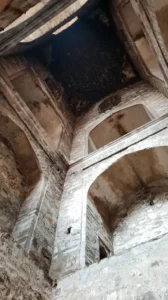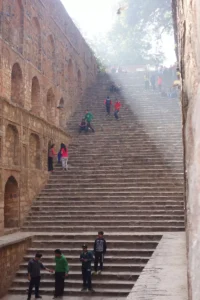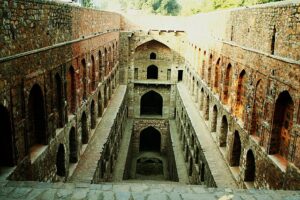AGRANSEN KI BAOLI: The Ancient Stepwell of Delhi
Historical Background

The origins of Agrasen Ki Baoli are shrouded in mystery and legend. It is believed to have been built during the time of Maharaja Agrasen, a legendary king of the Agrawal community, in the Mahabharata era. However, the current structure is thought to have been reconstructed in the 14th century during the Tughlaq dynasty’s rule. Despite the uncertainty surrounding its exact age, Agrasen Ki Baoli is a testament to the ingenuity and craftsmanship of ancient Indian engineers.
Architectural Marvel

Agrasen Ki Baoli is an architectural marvel, designed to serve both functional and aesthetic purposes. Stepwells, known as ‘baolis’ or ‘vavs’ in India, were constructed to provide water for drinking, irrigation, and bathing, particularly in arid regions. These structures also served as social and cultural hubs where people gathered, especially during the hot summer months.
The stepwell descends 60 meters deep and is 15 meters wide, with 108 steps leading down to the water reservoir at the bottom. It is built using red sandstone, which gives it a striking appearance. The design of Agrasen Ki Baoli reflects a harmonious blend of architectural styles, including Islamic, Persian, and Hindu influences. The stepwell is divided into three levels, each adorned with intricately carved arches and niches that showcase the exquisite craftsmanship of the era.
Structural Significance
The construction of stepwells like Agrasen Ki Baoli required advanced engineering techniques and a deep understanding of groundwater management. The baoli’s design includes a series of interconnected steps and landings that allow easy access to the water at various levels, even as the water level fluctuates with the seasons. This not only ensured a reliable water supply but also provided a cool and shaded retreat from the scorching sun.
One of the most remarkable features of Agrasen Ki Baoli is its acoustics. The stepwell’s design creates a unique sound effect, amplifying even the faintest whisper, making it an acoustical wonder. This feature has intrigued visitors and researchers, adding to the allure of this ancient structure.
Cultural and Social Hub
Modern-Day Relevance

Today, Agrasen Ki Baoli stands as a protected monument under the Archaeological Survey of India (ASI). It has been well-preserved, despite the challenges posed by urbanization and environmental factors. The baoli attracts tourists, history enthusiasts, and photographers from around the world, drawn by its historical significance and architectural beauty.
Agrasen Ki Baoli has also found its place in popular culture, featuring in Bollywood films, documentaries, and literature. Its mystique and charm make it a favorite spot for filmmakers and storytellers looking to capture the essence of Delhi’s historical landscape.
Conclusion
Agrasen Ki Baoli is a timeless architectural gem that embodies the ingenuity, culture, and community spirit of ancient India. Its intricate design, historical significance, and serene ambiance offer a unique window into the past, inviting visitors to explore and appreciate the rich heritage of Delhi. As we walk down the steps of Agrasen Ki Baoli, we are reminded of the remarkable engineering feats and the vibrant social life that once thrived within its walls. This ancient stepwell continues to inspire awe and wonder, standing as a silent witness to the passage of time and the enduring legacy of India’s architectural heritage.

Leave a Reply